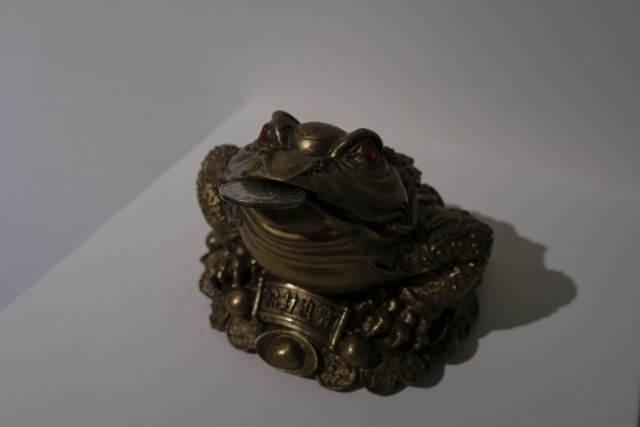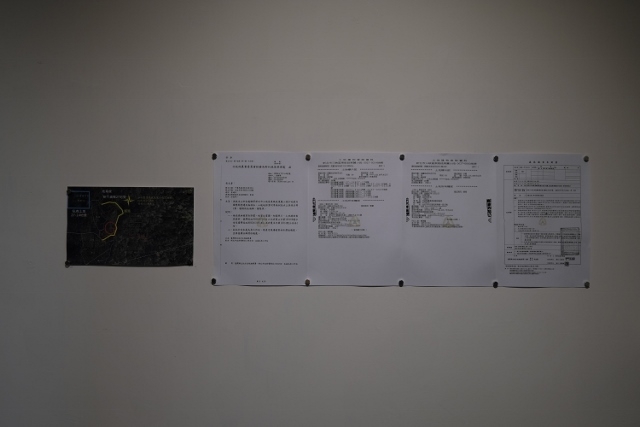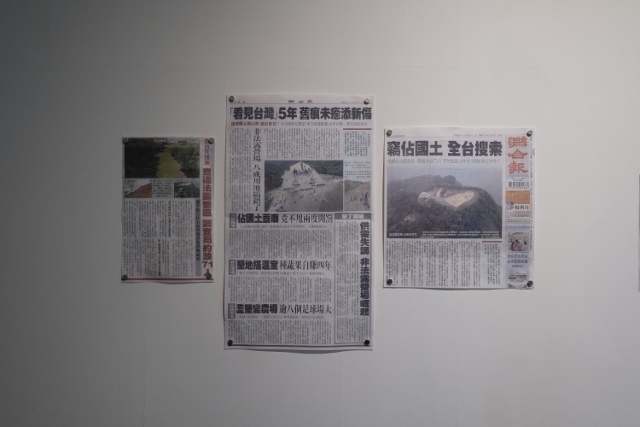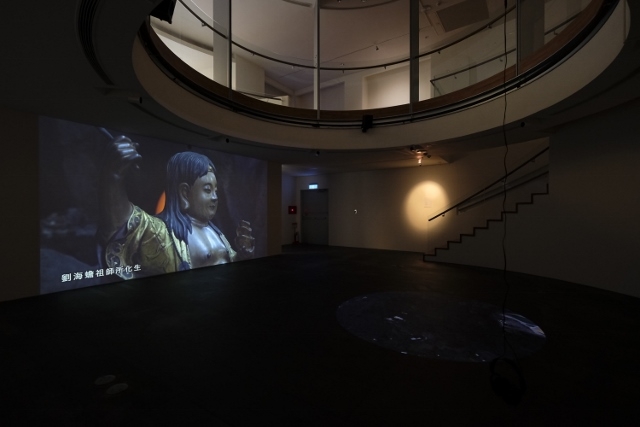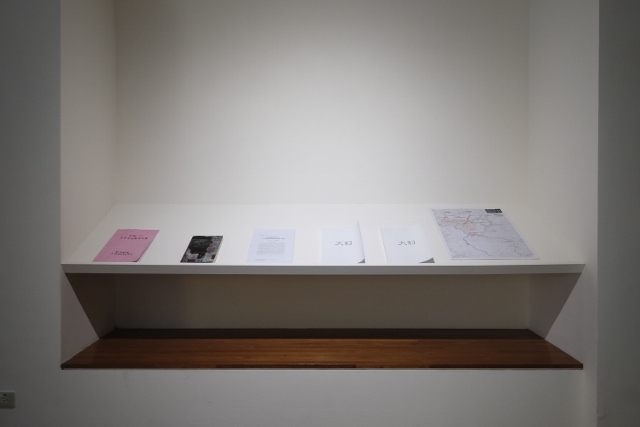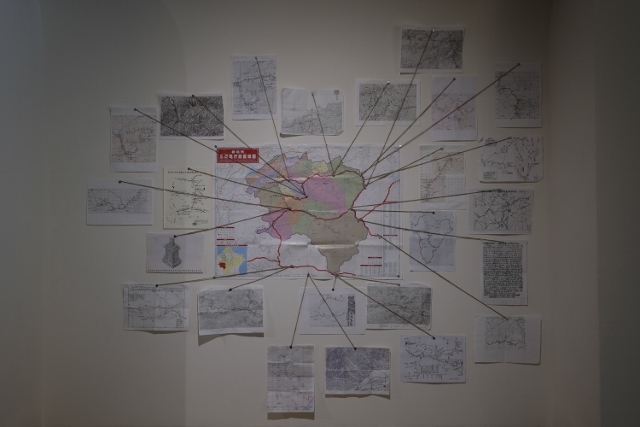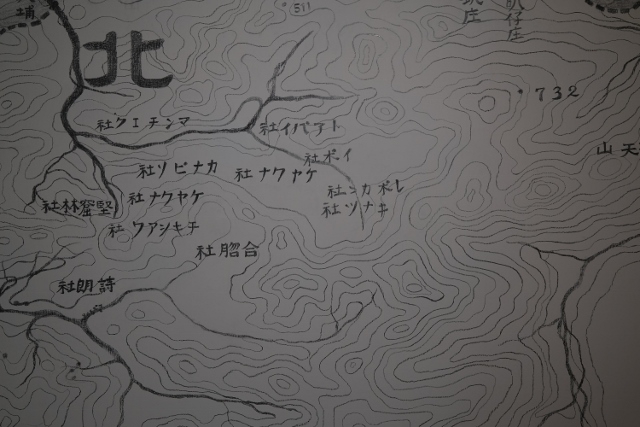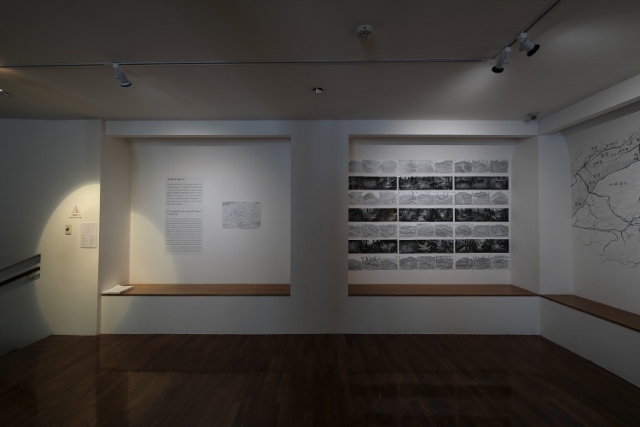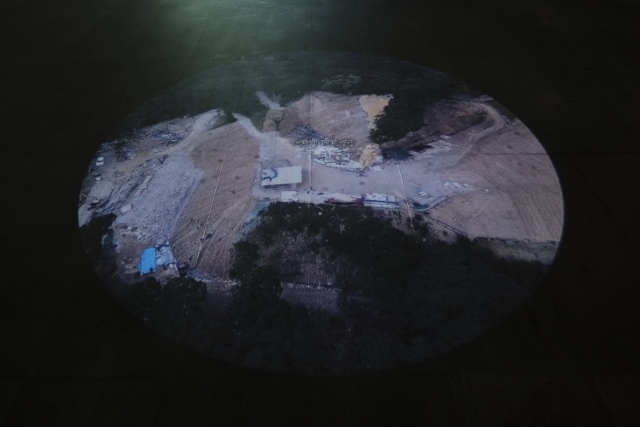Project Space-Taoist Trinity Fairyland Kao Junhonn Solo Exhibition
2018.07.27~2018.09.23
09:00 - 17:00
Reinventing places with contemporary art activism: Curatorial statement for
Taoist Trinity Fairyland,” the
Topa Project” of Jun-Honn Kao by / Sandy Hsiu-Chih Lo The
Taoist Trinity Fairyland" art project is related to an actual event of indiscriminate construction of a Taoist temple on the top of Toad Mountain in Sanxia District; it is also a part of Jun-Honn Kao's
Topa (Great Leopard) Project,” an ethnographic art action ongoing since 2016. He intends to reinvent the spaces for the Toad Mountain area and the Project Space in the Kuandu Museum. Jun-Honn Kao takes the perspective of
the Other"; that is, the Atayal Topa Community is the main gazer. The project’s focus is the construction of relational subjectivity based on the approach of
using the Other’s gaze as a mirror.” It adopts the concept of relativity and the relationship of spaces to embed cultural concepts such as myths, legends, history, memory, morality, ethics, desires, and rights in a dialectical pluralism of the concept of place; the intent is to strengthen the function of political and ethical transformation created by the contrast, confrontation, overlapping, and juxtaposition of the changing spaces. Based on the area around Toad Mountain and the Topa Creek, Jun-Honn Kao employs the advance of the defense line of the frontier guard in the Topa event as the axis, continues to travel through the historical time and space of the annihilation of the Topa Community and the actual time and space of the indiscriminately constructed
Taoist Trinity Fairyland"
in the name of God,” and uses documentary research, field investigation, image production, writing, and artistic action as detectors, measuring instruments, and mapping devices to re-explore, re-calibrate, and re-map a critical, autonomous, and emancipatory spectrum of topography between reality and imagination. During the exhibition, the field survey for
returning the scenes” is not only an art exhibition outside the white cube, but also a practice as an educational guerrilla classroom and a passing ceremony of liminality. Through this action, the social norms to which the participants are accustomed are temporarily invalidated, and participants are thrown into an unstable state that abandons the original social role but has not accepted the role of the new community. Therefore, it has the potential to subvert or rewrite the original social value. The
Project Space” of the Kuandu Museum is transformed into a heterogeneous space like "heterotopia" or "Third Space" due to the introduction of a fictional TV station, the video display of an art activity happened at the Topa Creek which appropriates and represents the
Ceremony of Burning Toads” in Nanchong County, Sichuan Province, China, the imaginary reconstruction of the traditional Topa territory, and the juxtaposition and superimposition of the wasteland after the dismantling of the
Taoist Trinity Fairyland,” a place with some fighting potential and agency. *Jun-Honn Kao’s solo exhibition,
Taoist Trinity Fairyland," is the first exhibition of the "Project Space,” the new art space of the Kuandu Museum.
Taoist Trinity Fairyland,” the
Topa Project” of Jun-Honn Kao by / Sandy Hsiu-Chih Lo The
Taoist Trinity Fairyland" art project is related to an actual event of indiscriminate construction of a Taoist temple on the top of Toad Mountain in Sanxia District; it is also a part of Jun-Honn Kao's
Topa (Great Leopard) Project,” an ethnographic art action ongoing since 2016. He intends to reinvent the spaces for the Toad Mountain area and the Project Space in the Kuandu Museum. Jun-Honn Kao takes the perspective of
the Other"; that is, the Atayal Topa Community is the main gazer. The project’s focus is the construction of relational subjectivity based on the approach of
using the Other’s gaze as a mirror.” It adopts the concept of relativity and the relationship of spaces to embed cultural concepts such as myths, legends, history, memory, morality, ethics, desires, and rights in a dialectical pluralism of the concept of place; the intent is to strengthen the function of political and ethical transformation created by the contrast, confrontation, overlapping, and juxtaposition of the changing spaces. Based on the area around Toad Mountain and the Topa Creek, Jun-Honn Kao employs the advance of the defense line of the frontier guard in the Topa event as the axis, continues to travel through the historical time and space of the annihilation of the Topa Community and the actual time and space of the indiscriminately constructed
Taoist Trinity Fairyland"
in the name of God,” and uses documentary research, field investigation, image production, writing, and artistic action as detectors, measuring instruments, and mapping devices to re-explore, re-calibrate, and re-map a critical, autonomous, and emancipatory spectrum of topography between reality and imagination. During the exhibition, the field survey for
returning the scenes” is not only an art exhibition outside the white cube, but also a practice as an educational guerrilla classroom and a passing ceremony of liminality. Through this action, the social norms to which the participants are accustomed are temporarily invalidated, and participants are thrown into an unstable state that abandons the original social role but has not accepted the role of the new community. Therefore, it has the potential to subvert or rewrite the original social value. The
Project Space” of the Kuandu Museum is transformed into a heterogeneous space like "heterotopia" or "Third Space" due to the introduction of a fictional TV station, the video display of an art activity happened at the Topa Creek which appropriates and represents the
Ceremony of Burning Toads” in Nanchong County, Sichuan Province, China, the imaginary reconstruction of the traditional Topa territory, and the juxtaposition and superimposition of the wasteland after the dismantling of the
Taoist Trinity Fairyland,” a place with some fighting potential and agency. *Jun-Honn Kao’s solo exhibition,
Taoist Trinity Fairyland," is the first exhibition of the "Project Space,” the new art space of the Kuandu Museum.
Reinventing places with contemporary art activism: Curatorial statement for
Taoist Trinity Fairyland,” the
Topa Project” of Jun-Honn Kao by / Sandy Hsiu-Chih Lo The
Taoist Trinity Fairyland" art project is related to an actual event of indiscriminate construction of a Taoist temple on the top of Toad Mountain in Sanxia District; it is also a part of Jun-Honn Kao's
Topa (Great Leopard) Project,” an ethnographic art action ongoing since 2016. He intends to reinvent the spaces for the Toad Mountain area and the Project Space in the Kuandu Museum. Jun-Honn Kao takes the perspective of
the Other"; that is, the Atayal Topa Community is the main gazer. The project’s focus is the construction of relational subjectivity based on the approach of
using the Other’s gaze as a mirror.” It adopts the concept of relativity and the relationship of spaces to embed cultural concepts such as myths, legends, history, memory, morality, ethics, desires, and rights in a dialectical pluralism of the concept of place; the intent is to strengthen the function of political and ethical transformation created by the contrast, confrontation, overlapping, and juxtaposition of the changing spaces. Based on the area around Toad Mountain and the Topa Creek, Jun-Honn Kao employs the advance of the defense line of the frontier guard in the Topa event as the axis, continues to travel through the historical time and space of the annihilation of the Topa Community and the actual time and space of the indiscriminately constructed
Taoist Trinity Fairyland"
in the name of God,” and uses documentary research, field investigation, image production, writing, and artistic action as detectors, measuring instruments, and mapping devices to re-explore, re-calibrate, and re-map a critical, autonomous, and emancipatory spectrum of topography between reality and imagination. During the exhibition, the field survey for
returning the scenes” is not only an art exhibition outside the white cube, but also a practice as an educational guerrilla classroom and a passing ceremony of liminality. Through this action, the social norms to which the participants are accustomed are temporarily invalidated, and participants are thrown into an unstable state that abandons the original social role but has not accepted the role of the new community. Therefore, it has the potential to subvert or rewrite the original social value. The
Project Space” of the Kuandu Museum is transformed into a heterogeneous space like "heterotopia" or "Third Space" due to the introduction of a fictional TV station, the video display of an art activity happened at the Topa Creek which appropriates and represents the
Ceremony of Burning Toads” in Nanchong County, Sichuan Province, China, the imaginary reconstruction of the traditional Topa territory, and the juxtaposition and superimposition of the wasteland after the dismantling of the
Taoist Trinity Fairyland,” a place with some fighting potential and agency. *Jun-Honn Kao’s solo exhibition,
Taoist Trinity Fairyland," is the first exhibition of the "Project Space,” the new art space of the Kuandu Museum.
Taoist Trinity Fairyland,” the
Topa Project” of Jun-Honn Kao by / Sandy Hsiu-Chih Lo The
Taoist Trinity Fairyland" art project is related to an actual event of indiscriminate construction of a Taoist temple on the top of Toad Mountain in Sanxia District; it is also a part of Jun-Honn Kao's
Topa (Great Leopard) Project,” an ethnographic art action ongoing since 2016. He intends to reinvent the spaces for the Toad Mountain area and the Project Space in the Kuandu Museum. Jun-Honn Kao takes the perspective of
the Other"; that is, the Atayal Topa Community is the main gazer. The project’s focus is the construction of relational subjectivity based on the approach of
using the Other’s gaze as a mirror.” It adopts the concept of relativity and the relationship of spaces to embed cultural concepts such as myths, legends, history, memory, morality, ethics, desires, and rights in a dialectical pluralism of the concept of place; the intent is to strengthen the function of political and ethical transformation created by the contrast, confrontation, overlapping, and juxtaposition of the changing spaces. Based on the area around Toad Mountain and the Topa Creek, Jun-Honn Kao employs the advance of the defense line of the frontier guard in the Topa event as the axis, continues to travel through the historical time and space of the annihilation of the Topa Community and the actual time and space of the indiscriminately constructed
Taoist Trinity Fairyland"
in the name of God,” and uses documentary research, field investigation, image production, writing, and artistic action as detectors, measuring instruments, and mapping devices to re-explore, re-calibrate, and re-map a critical, autonomous, and emancipatory spectrum of topography between reality and imagination. During the exhibition, the field survey for
returning the scenes” is not only an art exhibition outside the white cube, but also a practice as an educational guerrilla classroom and a passing ceremony of liminality. Through this action, the social norms to which the participants are accustomed are temporarily invalidated, and participants are thrown into an unstable state that abandons the original social role but has not accepted the role of the new community. Therefore, it has the potential to subvert or rewrite the original social value. The
Project Space” of the Kuandu Museum is transformed into a heterogeneous space like "heterotopia" or "Third Space" due to the introduction of a fictional TV station, the video display of an art activity happened at the Topa Creek which appropriates and represents the
Ceremony of Burning Toads” in Nanchong County, Sichuan Province, China, the imaginary reconstruction of the traditional Topa territory, and the juxtaposition and superimposition of the wasteland after the dismantling of the
Taoist Trinity Fairyland,” a place with some fighting potential and agency. *Jun-Honn Kao’s solo exhibition,
Taoist Trinity Fairyland," is the first exhibition of the "Project Space,” the new art space of the Kuandu Museum.
Jun Honn Kao is an artist and writer who lives and works in Taipei, Taiwan. His research-based works focus mainly on contemporary society in Taiwan, engaging space, politics, memories, and histories in the form of video art, physical practice, and writing. He graduated from Tainan National University of the Arts with a PhD in Art Creation. He is currently an Adjunct Associate Professor at Taipei National University of the Arts. He was the project director of “East Asia Multitude Meeting 2013: Post-Occupy (art/activism) Study” and has worked as documentary director exploring indigenous issues. He has held several solo exhibitions in Taiwan and abroad since 1995 and has been an artist in residence in Hong Kong, England, and France, among other locations. His book, “Archipelagos of Art” (including three volumes: “Novel: In the Name of Zhang Zhengguang,” “Multitude: Art Squats in East Asia,” and “Spintop: Politics of Life and My Creation”) received the Taiwan Golden Tripod Book Award in 2016. His artistic practice in recent years includes the investigation of East Asian art activists, “The Ruin Image Crystal Project,” the documentary project of "Bo Ai" in the satellite towns and townships in northern Taiwan, the "Traversing Archives: Taiwan's Mountain War, Empire and Image" on the development of modern Taiwan's forests, and the ongoing project regarding the indigenous people of Taiwan, called the “Topa Project.” Jun Honn Kao’s current research focuses on issues surrounding history and the multitudes, space, and indigenous and bio-politics. He uses documentary as one of his main forms of artistic practice and performs in-depth fieldwork for his studies, placing his findings within complex socio-economic contexts.
Jun Honn Kao is an artist and writer who lives and works in Taipei, Taiwan. His research-based works focus mainly on contemporary society in Taiwan, engaging space, politics, memories, and histories in the form of video art, physical practice, and writing. He graduated from Tainan National University of the Arts with a PhD in Art Creation. He is currently an Adjunct Associate Professor at Taipei National University of the Arts. He was the project director of “East Asia Multitude Meeting 2013: Post-Occupy (art/activism) Study” and has worked as documentary director exploring indigenous issues. He has held several solo exhibitions in Taiwan and abroad since 1995 and has been an artist in residence in Hong Kong, England, and France, among other locations. His book, “Archipelagos of Art” (including three volumes: “Novel: In the Name of Zhang Zhengguang,” “Multitude: Art Squats in East Asia,” and “Spintop: Politics of Life and My Creation”) received the Taiwan Golden Tripod Book Award in 2016. His artistic practice in recent years includes the investigation of East Asian art activists, “The Ruin Image Crystal Project,” the documentary project of "Bo Ai" in the satellite towns and townships in northern Taiwan, the "Traversing Archives: Taiwan's Mountain War, Empire and Image" on the development of modern Taiwan's forests, and the ongoing project regarding the indigenous people of Taiwan, called the “Topa Project.” Jun Honn Kao’s current research focuses on issues surrounding history and the multitudes, space, and indigenous and bio-politics. He uses documentary as one of his main forms of artistic practice and performs in-depth fieldwork for his studies, placing his findings within complex socio-economic contexts.
Reinventing places with contemporary art activism: Curatorial statement for “Taoist Trinity Fairyland,” the solo exhibition of Junhonn Kao /Sandy Hsiu-Chih Lo The “Taoist Trinity Fairyland" art project is related to an actual event of indiscriminate construction of a Taoist temple on the top of Toad Mountain in Sanxia District; it is also a part of Junhonn Kao's “Topa (Great Leopard) Project,” an ethnographic art action ongoing since 2016. He intends to reinvent the spaces for the Toad Mountain area and the Project Space in the Kuandu Museum. Junhonn Kao takes the perspective of “the Other"; that is, the Atayal Topa Community is the main gazer. The project’s focus is the construction of relational subjectivity based on the approach of “using the Other’s gaze as a mirror.” It adopts the concept of relativity and the relationship of spaces to embed cultural concepts such as myths, legends, history, memory, morality, ethics, desires, and rights in a dialectical pluralism of the concept of place; the intent is to strengthen the function of political and ethical transformation created by the contrast, confrontation, overlapping, and juxtaposition of the changing spaces. Based on the area around Toad Mountain and the Topa Creek, Junhonn Kao employs the advance of the defense line of the frontier guard in the Topa event as the axis, continues to travel through the historical time and space of the annihilation of the Topa Community and the actual time and space of the indiscriminately constructed “Taoist Trinity Fairyland" “in the name of God,” and uses documentary research, field investigation, image production, writing, and artistic action as detectors, measuring instruments, and mapping devices to re-explore, re-calibrate, and re-map a critical, autonomous, and emancipatory spectrum of topography between reality and imagination. During the exhibition, the field survey for “returning the scenes” is not only an art exhibition outside the white cube, but also a practice as an educational guerrilla classroom and a passing ceremony of liminality. Through this action, the social norms to which the participants are accustomed are temporarily invalidated, and participants are thrown into an unstable state that abandons the original social role but has not accepted the role of the new community. Therefore, it has the potential to subvert or rewrite the original social value. The “Project Space” of the Kuandu Museum is transformed into a heterogeneous space like "heterotopia" or "Third Space" due to the introduction of a fictional TV station, the imaginary reconstruction of the traditional Topa territory, and the juxtaposition and superimposition of the wasteland after the dismantling of the “Taoist Trinity Fairyland,” a place with some fighting potential and agency. *Jun-honn Kao’s solo exhibition, “Taoist Trinity Fairyland," is the first exhibition of the "Project Space,” the new art space of the Kuandu Museum.
Reinventing places with contemporary art activism: Curatorial statement for “Taoist Trinity Fairyland,” the solo exhibition of Junhonn Kao /Sandy Hsiu-Chih Lo The “Taoist Trinity Fairyland" art project is related to an actual event of indiscriminate construction of a Taoist temple on the top of Toad Mountain in Sanxia District; it is also a part of Junhonn Kao's “Topa (Great Leopard) Project,” an ethnographic art action ongoing since 2016. He intends to reinvent the spaces for the Toad Mountain area and the Project Space in the Kuandu Museum. Junhonn Kao takes the perspective of “the Other"; that is, the Atayal Topa Community is the main gazer. The project’s focus is the construction of relational subjectivity based on the approach of “using the Other’s gaze as a mirror.” It adopts the concept of relativity and the relationship of spaces to embed cultural concepts such as myths, legends, history, memory, morality, ethics, desires, and rights in a dialectical pluralism of the concept of place; the intent is to strengthen the function of political and ethical transformation created by the contrast, confrontation, overlapping, and juxtaposition of the changing spaces. Based on the area around Toad Mountain and the Topa Creek, Junhonn Kao employs the advance of the defense line of the frontier guard in the Topa event as the axis, continues to travel through the historical time and space of the annihilation of the Topa Community and the actual time and space of the indiscriminately constructed “Taoist Trinity Fairyland" “in the name of God,” and uses documentary research, field investigation, image production, writing, and artistic action as detectors, measuring instruments, and mapping devices to re-explore, re-calibrate, and re-map a critical, autonomous, and emancipatory spectrum of topography between reality and imagination. During the exhibition, the field survey for “returning the scenes” is not only an art exhibition outside the white cube, but also a practice as an educational guerrilla classroom and a passing ceremony of liminality. Through this action, the social norms to which the participants are accustomed are temporarily invalidated, and participants are thrown into an unstable state that abandons the original social role but has not accepted the role of the new community. Therefore, it has the potential to subvert or rewrite the original social value. The “Project Space” of the Kuandu Museum is transformed into a heterogeneous space like "heterotopia" or "Third Space" due to the introduction of a fictional TV station, the imaginary reconstruction of the traditional Topa territory, and the juxtaposition and superimposition of the wasteland after the dismantling of the “Taoist Trinity Fairyland,” a place with some fighting potential and agency. *Jun-honn Kao’s solo exhibition, “Taoist Trinity Fairyland," is the first exhibition of the "Project Space,” the new art space of the Kuandu Museum.
